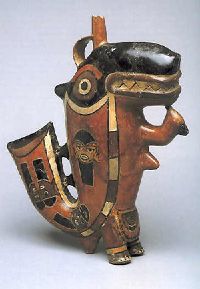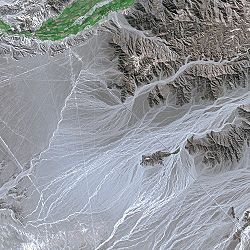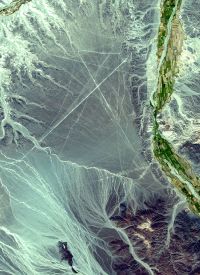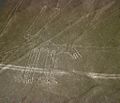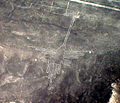Difference between revisions of "Nazca Lines" - New World Encyclopedia
Rosie Tanabe (talk | contribs) |
Rosie Tanabe (talk | contribs) |
||
| (6 intermediate revisions by one other user not shown) | |||
| Line 23: | Line 23: | ||
==Overview of Nasca culture== | ==Overview of Nasca culture== | ||
The [[Nasca culture]] flourished from the first to eighth centuries C.E. beside the dry southern coast of [[Peru]] in the river valleys of the [[Rio Grande de Nazca]] drainage and the [[Ica Region|Ica Valley]].<ref name=Nasca> Helaine Silverman and Donald Proulx, ''The Nasca'', (Wiley-Blackwell, 2002, ISBN 0631232249).</ref> Early Nasca society was made up of local [[chiefdom]]s and regional centers of power centered around Cahuachi, a non-urban ceremonial site of mounds and plazas.<ref>Lidio M. Valdez, "Cahuachi: New Evidence for an Early Nasca Ceremonial Role" in ''Current Anthropology'', 35(5) (December 1994): 675-679.</ref> Heavily influenced by the preceding [[Paracas culture]], which was known for extremely complex [[textile]]s, the Nasca produced an array of beautiful crafts and technologies such as [[ceramic]]s, textiles, along with the famous Nazca lines and [[geoglyph]]s. | The [[Nasca culture]] flourished from the first to eighth centuries C.E. beside the dry southern coast of [[Peru]] in the river valleys of the [[Rio Grande de Nazca]] drainage and the [[Ica Region|Ica Valley]].<ref name=Nasca> Helaine Silverman and Donald Proulx, ''The Nasca'', (Wiley-Blackwell, 2002, ISBN 0631232249).</ref> Early Nasca society was made up of local [[chiefdom]]s and regional centers of power centered around Cahuachi, a non-urban ceremonial site of mounds and plazas.<ref>Lidio M. Valdez, "Cahuachi: New Evidence for an Early Nasca Ceremonial Role" in ''Current Anthropology'', 35(5) (December 1994): 675-679.</ref> Heavily influenced by the preceding [[Paracas culture]], which was known for extremely complex [[textile]]s, the Nasca produced an array of beautiful crafts and technologies such as [[ceramic]]s, textiles, along with the famous Nazca lines and [[geoglyph]]s. | ||
| − | [[Image:Orca mitica nasca.jpg|thumb|left|''Killer Whale,'' Nasca Culture, pottery, [[Larco Museum]], [[Lima]], [[Perú]].]] | + | [[Image:Orca mitica nasca.jpg|thumb|left|200px|''Killer Whale,'' Nasca Culture, pottery, [[Larco Museum]], [[Lima]], [[Perú]].]] |
Nazca subsistence was based largely on [[agriculture]]. [[Iconography]] on ceramics and excavated remains indicate that the Nazca people had a varied diet composed of [[maize]], [[Squash (plant)|squash]], [[sweet potato]], [[manioc]], and [[achira]], and even a small trace of various fish. They also utilized several non-food crops such as [[cotton]] for textiles, coca, San Pedro cactus, and [[gourd]]s which were also used to illustrate activities in daily life. In terms of animal resources, the Nasca used the [[llama]] and [[guinea pig]] for sacrifice at Cahuachi. Llamas were also commonly exploited as pack animals, for their [[wool]], and as a source of meat.<ref name=Nasca/> | Nazca subsistence was based largely on [[agriculture]]. [[Iconography]] on ceramics and excavated remains indicate that the Nazca people had a varied diet composed of [[maize]], [[Squash (plant)|squash]], [[sweet potato]], [[manioc]], and [[achira]], and even a small trace of various fish. They also utilized several non-food crops such as [[cotton]] for textiles, coca, San Pedro cactus, and [[gourd]]s which were also used to illustrate activities in daily life. In terms of animal resources, the Nasca used the [[llama]] and [[guinea pig]] for sacrifice at Cahuachi. Llamas were also commonly exploited as pack animals, for their [[wool]], and as a source of meat.<ref name=Nasca/> | ||
| − | No doubt due to the extreme nature of the surrounding environment, much of Nasca [[religion|religious]] beliefs centered around agriculture and fertility. Much of Nasca art depicts powerful nature gods such as the mythical killer whale, the harvesters, the mythical spotted cat, the serpentine creature, and the most prevalent of worshiped figures, the anthropomorphic mythical being. Much like the contemporary [[Moche culture]], [[shaman]]s apparently used [[hallucinogen]]ic drugs, such as extractions from the [[San Pedro cactus]], to induce visions.<ref name=Nasca/> Religious events and ceremonies took place at the center of Nasca society, in Cahuachi. During these times, all members of the society in surrounding villages would migrate to the center and participate in feasting as well. Non-elites could obtain highly valued goods such as fancy polychrome [[pottery]]. In exchange, the elites could enhance their political power and status while opting the commoners into labor and construction of the site.<ref> Helaine Silverman, "Cahuachi: Non-Urban Cultural Complexity on the South Coast of Peru" in ''Journal of Field Archaeology'' | + | No doubt due to the extreme nature of the surrounding environment, much of Nasca [[religion|religious]] beliefs centered around agriculture and fertility. Much of Nasca art depicts powerful nature gods such as the mythical killer whale, the harvesters, the mythical spotted cat, the serpentine creature, and the most prevalent of worshiped figures, the anthropomorphic mythical being. Much like the contemporary [[Moche culture]], [[shaman]]s apparently used [[hallucinogen]]ic drugs, such as extractions from the [[San Pedro cactus]], to induce visions.<ref name=Nasca/> Religious events and ceremonies took place at the center of Nasca society, in Cahuachi. During these times, all members of the society in surrounding villages would migrate to the center and participate in feasting as well. Non-elites could obtain highly valued goods such as fancy polychrome [[pottery]]. In exchange, the elites could enhance their political power and status while opting the commoners into labor and construction of the site.<ref> Helaine Silverman, "Cahuachi: Non-Urban Cultural Complexity on the South Coast of Peru" in ''Journal of Field Archaeology'' 15(4) (1988): 403-430.</ref> |
==Construction of Nazca lines== | ==Construction of Nazca lines== | ||
[[Image:Nazca Lines SPOT 1311.jpg|right|250px|thumb|Nazca Lines seen from Spot Satellite]] | [[Image:Nazca Lines SPOT 1311.jpg|right|250px|thumb|Nazca Lines seen from Spot Satellite]] | ||
| − | The lines were made by removing the reddish-brown [[iron oxide]]-coated pebbles, which cover the surface of the Nazca [[desert]]. When the gravel is removed, the lines contrast sharply with the light-colored earth beneath. There are several hundred simple lines and [[geometry|geometric]] patterns on the Nazca plateau, as well as over 70 curvilinear animal and human figures. The lines persist due to the extremely dry, windless, and constant climate of the Nazca region. The Nazca desert is one of the driest on earth and maintains a temperature around {{convert|77|°F}} all year round, and the lack of wind has helped keep the lines uncovered to the present day.<ref name=krystek>Lee Krystek, [http://unmuseum.mus.pa.us/nazca.htm The Lines of Nazca Peru], ''The UnMuseum''. Retrieved | + | The lines were made by removing the reddish-brown [[iron oxide]]-coated pebbles, which cover the surface of the Nazca [[desert]]. When the gravel is removed, the lines contrast sharply with the light-colored earth beneath. There are several hundred simple lines and [[geometry|geometric]] patterns on the Nazca plateau, as well as over 70 curvilinear animal and human figures. The lines persist due to the extremely dry, windless, and constant climate of the Nazca region. The Nazca desert is one of the driest on earth and maintains a temperature around {{convert|77|°F}} all year round, and the lack of wind has helped keep the lines uncovered to the present day.<ref name=krystek>Lee Krystek, [http://unmuseum.mus.pa.us/nazca.htm The Lines of Nazca Peru], ''The UnMuseum''. Retrieved October 19, 2020.</ref> |
The leading explanation for the method of construction employed by the Nasca people involves the use of simple tools and [[surveying]] equipment. Wooden stakes in the ground at the end of some lines (which were used to [[Radiocarbon dating|carbon-date]] the figures) and [[ceramic]]s found on the surface support this theory. | The leading explanation for the method of construction employed by the Nasca people involves the use of simple tools and [[surveying]] equipment. Wooden stakes in the ground at the end of some lines (which were used to [[Radiocarbon dating|carbon-date]] the figures) and [[ceramic]]s found on the surface support this theory. | ||
| Line 37: | Line 37: | ||
==Discovery and investigation== | ==Discovery and investigation== | ||
| − | The Nazca lines did not garner the attention of modern society until the early twentieth century when [[airplane]]s began flying over the region. As more and more reports came in of strange markings in [[Peru]], interest in the area heightened. In the early 1940s, American [[Anthropology|anthropologist]] [[Paul Kosok]] came to study the [[irrigation]] systems of ancient South American cultures, and soon became fascinated with the Nazca Lines.<ref name=travel> Peru Travel Diary, [http://www.machupicchu-inca.com/nazca-lines-mystery.html Nazca Lines Mysteries: Can anybody solve them? Ever?], ''Machupicchu-inca.com'', 2008. Retrieved | + | The Nazca lines did not garner the attention of modern society until the early twentieth century when [[airplane]]s began flying over the region. As more and more reports came in of strange markings in [[Peru]], interest in the area heightened. In the early 1940s, American [[Anthropology|anthropologist]] [[Paul Kosok]] came to study the [[irrigation]] systems of ancient South American cultures, and soon became fascinated with the Nazca Lines.<ref name=travel> Peru Travel Diary, [http://www.machupicchu-inca.com/nazca-lines-mystery.html Nazca Lines Mysteries: Can anybody solve them? Ever?], ''Machupicchu-inca.com'', 2008. Retrieved October 19, 2020.</ref> Not long after he was joined by [[Germany|German]] [[Mathematics|mathematician]] and archaeologist [[Maria Reiche]] who helped Kosok study the markings for several years. Together, Kosok and Reiche advanced one of the earliest reasons given for the Nazca Lines: that they were markers on the [[horizon]] to indicate where the [[sun]] and other celestial bodies rose or set.<ref name=travel/> Whereas Kosok spent around a decade studying the Nazca Lines, Reiche spent nearly the remainder of her life studying the phenomena, revising her theory to suggest that the artwork was actually an [[astronomy|astronomical]] map of [[constellation]]s.<ref name=scitec>[http://www.sciteclibrary.ru/eng/catalog/pages/741.html A Mystery of the Legendary Naska's Lines in Peru Seems to be Resolved], ''SciTecLibrary.com'', December 5, 2000. Retrieved October 19, 2020.</ref> |
Since Kosok and Reiche, numerous archaeologists, anthropologists, and other scientists have studied the area, and there are numerous explanations and theories as to the meaning of the lines. | Since Kosok and Reiche, numerous archaeologists, anthropologists, and other scientists have studied the area, and there are numerous explanations and theories as to the meaning of the lines. | ||
| − | [[Image:NEO nazca lines big.jpg|right|200px|thumb|Satellite picture of an area containing lines. (Coordinates: {{coord|14|43|S|75|08|W|}})]] | + | [[Image:NEO nazca lines big.jpg|right|200px|thumb|Satellite picture of an area containing lines. (Coordinates: {{coord|14|43|S|75|08|W|}})]] |
| − | In the late 1960s, American astronomer [[Gerald Hawkins]] tested Kosok and Reiche's theories about the lines having astronomical significance and found that there was insufficient evidence to confirm their correspondence to the [[star]] locations and other astronomical phenomena.<ref name=krystek/> Notwithstanding Hawkins' dismissal of an astronomical explanation of the Nazca Lines and [[geoglyph]]s, astronomer Robin Edgar theorized that the Nazca Lines, particularly the biomorph geoglyphs that depict animals, human figures, birds, and "flowers" are an ancient response to what he called the "Eye of God" that is manifested in the sky during a total [[solar eclipse]].<ref name=lineas>[http://www.bibliotecapleyades.net/nazca/esp_lineas_nazca_2.htm Nazca Line Theories], ''Las Lineas de Nazca''. Retrieved | + | In the late 1960s, American astronomer [[Gerald Hawkins]] tested Kosok and Reiche's theories about the lines having astronomical significance and found that there was insufficient evidence to confirm their correspondence to the [[star]] locations and other astronomical phenomena.<ref name=krystek/> Notwithstanding Hawkins' dismissal of an astronomical explanation of the Nazca Lines and [[geoglyph]]s, astronomer Robin Edgar theorized that the Nazca Lines, particularly the biomorph geoglyphs that depict animals, human figures, birds, and "flowers" are an ancient response to what he called the "Eye of God" that is manifested in the sky during a total [[solar eclipse]].<ref name=lineas>[http://www.bibliotecapleyades.net/nazca/esp_lineas_nazca_2.htm Nazca Line Theories], ''Las Lineas de Nazca''. Retrieved October 19, 2020.</ref> |
In 1985, archaeologist [[Johan Reinhard]] published archaeological, ethnographic, and historical data demonstrating that worship of [[mountain]]s and other [[water]] sources played a dominant role in Nazca [[religion]] and [[economy]] from ancient to recent times. He presented the theory that the lines and figures can be explained as part of religious practices involving the worship of [[deity|deities]] associated with the availability of water and thus the [[fertility]] of crops. The lines were interpreted as being used primarily as sacred paths leading to places where these deities could be worshiped and the figures as symbolically representing animals and objects meant to invoke their aid. However, the precise meanings of many of the individual geoglyphs remained unsolved.<ref name=krystek/> | In 1985, archaeologist [[Johan Reinhard]] published archaeological, ethnographic, and historical data demonstrating that worship of [[mountain]]s and other [[water]] sources played a dominant role in Nazca [[religion]] and [[economy]] from ancient to recent times. He presented the theory that the lines and figures can be explained as part of religious practices involving the worship of [[deity|deities]] associated with the availability of water and thus the [[fertility]] of crops. The lines were interpreted as being used primarily as sacred paths leading to places where these deities could be worshiped and the figures as symbolically representing animals and objects meant to invoke their aid. However, the precise meanings of many of the individual geoglyphs remained unsolved.<ref name=krystek/> | ||
| Line 54: | Line 54: | ||
Others, such as [[Hermann E. Boss]] have also postulated an alien origin for the lines.<ref name=lineas/> Author [[Robert Bast]] has proposed that the symbols of animals and humans, positioned in a way that they appear to be laying on the ground, were created out of a collective memory of an ancient [[flood]], a theory that corresponds to, but is not necessarily the same, as the [[Christianity|Christian]] belief in [[Noah]] and the [[Great Flood|Flood]]. Some have also suggested that the Nazca Lines are one of many mystical areas around the planet that possess energy [[vortex|vortices]] and are hot spots for paranormal activity. | Others, such as [[Hermann E. Boss]] have also postulated an alien origin for the lines.<ref name=lineas/> Author [[Robert Bast]] has proposed that the symbols of animals and humans, positioned in a way that they appear to be laying on the ground, were created out of a collective memory of an ancient [[flood]], a theory that corresponds to, but is not necessarily the same, as the [[Christianity|Christian]] belief in [[Noah]] and the [[Great Flood|Flood]]. Some have also suggested that the Nazca Lines are one of many mystical areas around the planet that possess energy [[vortex|vortices]] and are hot spots for paranormal activity. | ||
| + | |||
| + | ==Palpas glyphs== | ||
| + | The [[Paracas culture]] is considered by some historians to be the possible precursor that influenced the development of the Nazca Lines. In 2018, drones used by archaeologists revealed 25 [[geoglyph]]s in the [[Palpa province]] from the Paracas culture. Many predate the associated Nazca lines by a thousand years. Some demonstrate a significant difference in the subjects and locations, such as some being on hillsides.<ref>[https://www.reuters.com/article/us-peru-archaeology/archaeologists-discover-new-geoglyphs-near-nazca-lines-in-peru-idUSKCN1IT1TG Archaeologists discover new geoglyphs near Nazca Lines in Peru] ''Reuters'', May 29, 2018. Retrieved October 19, 2020.</ref> | ||
| + | |||
| + | In 2020, the figure of a cat was discovered on a hillside overlooking the Nazca desert. The geoglyph, which is about 37 meters (120 ft) long, is from the Paracas era and is in the same style as other images from the Paracas culture.<ref>[https://www.bbc.com/news/world-latin-america-54593295 Large 2,000-year-old cat discovered in Peru's Nazca lines] ''BBC'', October 18, 2020. Retrieved October 19, 2020.</ref> | ||
==Gallery== | ==Gallery== | ||
| Line 80: | Line 85: | ||
==External links== | ==External links== | ||
| − | All links retrieved November | + | All links retrieved November 11, 2022. |
| − | *[http://whc.unesco.org/en/list/700/ Lines and Geoglyphs of Nasca and Pampas de Jumana] | + | *[http://whc.unesco.org/en/list/700/ Lines and Geoglyphs of Nasca and Pampas de Jumana] UNESCO World Heritage |
| − | *[ | + | *[https://www.nationalgeographic.com/history/archaeology/nasca-lines/ Why the Nasca lines are among Peru's greatest mysteries] ''National Geographic'' |
| − | *[http://www.crystalinks.com/nasca.html Nazca Lines and Cahuachi Culture] | + | *[http://www.crystalinks.com/nasca.html Nazca Lines and Cahuachi Culture] |
*[http://www-unix.oit.umass.edu/~proulx/Nasca_Lines_Project.html The Nasca Lines Project (1996-2000)]. | *[http://www-unix.oit.umass.edu/~proulx/Nasca_Lines_Project.html The Nasca Lines Project (1996-2000)]. | ||
| + | *[https://www.history.com/topics/south-america/nazca-lines Nazca Lines] ''History.com'' | ||
{{World Heritage Sites in Peru}} | {{World Heritage Sites in Peru}} | ||
{{Credit|246553014}} | {{Credit|246553014}} | ||
Latest revision as of 15:59, 11 November 2022
| Lines and Geoglyphs of Nazca and Pampas de Jumana* | |
|---|---|
| UNESCO World Heritage Site | |
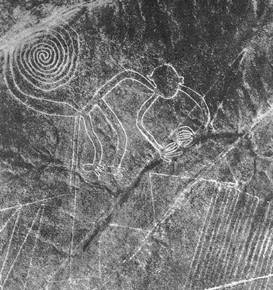
| |
| State Party | |
| Type | Cultural |
| Criteria | i, iii, iv |
| Reference | 700 |
| Region** | Latin America and the Caribbean |
| Inscription history | |
| Inscription | 1994 (18th Session) |
| * Name as inscribed on World Heritage List. ** Region as classified by UNESCO. | |
The Nazca lines are a series of geoglyphs located in the Nazca Desert, a high arid plateau that stretches more than 80 km (50 miles) between the towns of Nazca and Palpa on the Pampas de Jumana in Peru. They are believed to have been created by the Nasca culture between 200 B.C.E. and 700 C.E. The region's dry and windy climate has kept the lines clear. Visible from the air, the designs are less noticeable from ground level. Thus, in the twentieth century when airplanes began flying over this area the markings stirred up great interest. In 1994, the Nazca plain was deemed a UNESCO Heritage Site, in order to protect the ancient creations from modern human encroachment.
The lines form numerous individual figures, ranging in complexity from simple lines to stylized hummingbirds, spiders, monkeys, fish, sharks, llamas, and lizards. The Nazca Lines remain one of the many mysteries of the ancient world, with suggested explanations ranging from astronomical calendar, sacred paths, to UFO markings made by extraterrestrials. Thus, the Nazca Lines reflect the creativity of human beings, both in their design and construction by the ancient culture, and in efforts to decipher them by contemporary researchers.
Overview of Nasca culture
The Nasca culture flourished from the first to eighth centuries C.E. beside the dry southern coast of Peru in the river valleys of the Rio Grande de Nazca drainage and the Ica Valley.[1] Early Nasca society was made up of local chiefdoms and regional centers of power centered around Cahuachi, a non-urban ceremonial site of mounds and plazas.[2] Heavily influenced by the preceding Paracas culture, which was known for extremely complex textiles, the Nasca produced an array of beautiful crafts and technologies such as ceramics, textiles, along with the famous Nazca lines and geoglyphs.
Nazca subsistence was based largely on agriculture. Iconography on ceramics and excavated remains indicate that the Nazca people had a varied diet composed of maize, squash, sweet potato, manioc, and achira, and even a small trace of various fish. They also utilized several non-food crops such as cotton for textiles, coca, San Pedro cactus, and gourds which were also used to illustrate activities in daily life. In terms of animal resources, the Nasca used the llama and guinea pig for sacrifice at Cahuachi. Llamas were also commonly exploited as pack animals, for their wool, and as a source of meat.[1]
No doubt due to the extreme nature of the surrounding environment, much of Nasca religious beliefs centered around agriculture and fertility. Much of Nasca art depicts powerful nature gods such as the mythical killer whale, the harvesters, the mythical spotted cat, the serpentine creature, and the most prevalent of worshiped figures, the anthropomorphic mythical being. Much like the contemporary Moche culture, shamans apparently used hallucinogenic drugs, such as extractions from the San Pedro cactus, to induce visions.[1] Religious events and ceremonies took place at the center of Nasca society, in Cahuachi. During these times, all members of the society in surrounding villages would migrate to the center and participate in feasting as well. Non-elites could obtain highly valued goods such as fancy polychrome pottery. In exchange, the elites could enhance their political power and status while opting the commoners into labor and construction of the site.[3]
Construction of Nazca lines
The lines were made by removing the reddish-brown iron oxide-coated pebbles, which cover the surface of the Nazca desert. When the gravel is removed, the lines contrast sharply with the light-colored earth beneath. There are several hundred simple lines and geometric patterns on the Nazca plateau, as well as over 70 curvilinear animal and human figures. The lines persist due to the extremely dry, windless, and constant climate of the Nazca region. The Nazca desert is one of the driest on earth and maintains a temperature around 77 °F (25 °C) all year round, and the lack of wind has helped keep the lines uncovered to the present day.[4]
The leading explanation for the method of construction employed by the Nasca people involves the use of simple tools and surveying equipment. Wooden stakes in the ground at the end of some lines (which were used to carbon-date the figures) and ceramics found on the surface support this theory.
The area encompassing the lines is nearly 500 square kilometers (193 square miles), and the largest figures can be nearly 270 meters (890 ft) long, although the dimensions of each figure varies. The Hummingbird is 93 meters (310 ft) long, the Condor is 134 meters (440 ft), the Monkey is 93 meters (310 ft) by 58 meters (190 ft), and the Spider is 47 meters (150 ft).
Discovery and investigation
The Nazca lines did not garner the attention of modern society until the early twentieth century when airplanes began flying over the region. As more and more reports came in of strange markings in Peru, interest in the area heightened. In the early 1940s, American anthropologist Paul Kosok came to study the irrigation systems of ancient South American cultures, and soon became fascinated with the Nazca Lines.[5] Not long after he was joined by German mathematician and archaeologist Maria Reiche who helped Kosok study the markings for several years. Together, Kosok and Reiche advanced one of the earliest reasons given for the Nazca Lines: that they were markers on the horizon to indicate where the sun and other celestial bodies rose or set.[5] Whereas Kosok spent around a decade studying the Nazca Lines, Reiche spent nearly the remainder of her life studying the phenomena, revising her theory to suggest that the artwork was actually an astronomical map of constellations.[6]
Since Kosok and Reiche, numerous archaeologists, anthropologists, and other scientists have studied the area, and there are numerous explanations and theories as to the meaning of the lines.
In the late 1960s, American astronomer Gerald Hawkins tested Kosok and Reiche's theories about the lines having astronomical significance and found that there was insufficient evidence to confirm their correspondence to the star locations and other astronomical phenomena.[4] Notwithstanding Hawkins' dismissal of an astronomical explanation of the Nazca Lines and geoglyphs, astronomer Robin Edgar theorized that the Nazca Lines, particularly the biomorph geoglyphs that depict animals, human figures, birds, and "flowers" are an ancient response to what he called the "Eye of God" that is manifested in the sky during a total solar eclipse.[7]
In 1985, archaeologist Johan Reinhard published archaeological, ethnographic, and historical data demonstrating that worship of mountains and other water sources played a dominant role in Nazca religion and economy from ancient to recent times. He presented the theory that the lines and figures can be explained as part of religious practices involving the worship of deities associated with the availability of water and thus the fertility of crops. The lines were interpreted as being used primarily as sacred paths leading to places where these deities could be worshiped and the figures as symbolically representing animals and objects meant to invoke their aid. However, the precise meanings of many of the individual geoglyphs remained unsolved.[4]
Another theory contends that the lines are the remains of "walking temples," where a large group of worshipers walked along a preset pattern dedicated to a particular holy entity, similar to the practice of labyrinth walking. Residents of the local villages say the ancient Nasca conducted rituals on these giant drawings to thank the gods and to ensure that water would continue to flow from the Andes.[6]
As archaeologists and others continued to study the Nazca Lines, more theories of this ancient mystery have been generated. However, since the culture that produced these works has been gone for centuries, and left little record beyond the Nazca lines and other artifacts, the truth behind these artworks has been difficult to ascertain.
Paranormal explanations
Outside of mainstream archaeology and anthropology, the Nazca lines, like many ancient and not well understood monuments, have generated numerous paranormal explanations. The most famous is Erich von Däniken's theory that the lines were created by extraterrestrials who visited the Earth in ancient times.[7] The large size of the markings, their precisions, and the fact that their scope is best observed from the sky, led Däniken to theorize aliens had created the markings.
Others, such as Hermann E. Boss have also postulated an alien origin for the lines.[7] Author Robert Bast has proposed that the symbols of animals and humans, positioned in a way that they appear to be laying on the ground, were created out of a collective memory of an ancient flood, a theory that corresponds to, but is not necessarily the same, as the Christian belief in Noah and the Flood. Some have also suggested that the Nazca Lines are one of many mystical areas around the planet that possess energy vortices and are hot spots for paranormal activity.
Palpas glyphs
The Paracas culture is considered by some historians to be the possible precursor that influenced the development of the Nazca Lines. In 2018, drones used by archaeologists revealed 25 geoglyphs in the Palpa province from the Paracas culture. Many predate the associated Nazca lines by a thousand years. Some demonstrate a significant difference in the subjects and locations, such as some being on hillsides.[8]
In 2020, the figure of a cat was discovered on a hillside overlooking the Nazca desert. The geoglyph, which is about 37 meters (120 ft) long, is from the Paracas era and is in the same style as other images from the Paracas culture.[9]
Gallery
Notes
- ↑ 1.0 1.1 1.2 Helaine Silverman and Donald Proulx, The Nasca, (Wiley-Blackwell, 2002, ISBN 0631232249).
- ↑ Lidio M. Valdez, "Cahuachi: New Evidence for an Early Nasca Ceremonial Role" in Current Anthropology, 35(5) (December 1994): 675-679.
- ↑ Helaine Silverman, "Cahuachi: Non-Urban Cultural Complexity on the South Coast of Peru" in Journal of Field Archaeology 15(4) (1988): 403-430.
- ↑ 4.0 4.1 4.2 Lee Krystek, The Lines of Nazca Peru, The UnMuseum. Retrieved October 19, 2020.
- ↑ 5.0 5.1 Peru Travel Diary, Nazca Lines Mysteries: Can anybody solve them? Ever?, Machupicchu-inca.com, 2008. Retrieved October 19, 2020.
- ↑ 6.0 6.1 A Mystery of the Legendary Naska's Lines in Peru Seems to be Resolved, SciTecLibrary.com, December 5, 2000. Retrieved October 19, 2020.
- ↑ 7.0 7.1 7.2 Nazca Line Theories, Las Lineas de Nazca. Retrieved October 19, 2020.
- ↑ Archaeologists discover new geoglyphs near Nazca Lines in Peru Reuters, May 29, 2018. Retrieved October 19, 2020.
- ↑ Large 2,000-year-old cat discovered in Peru's Nazca lines BBC, October 18, 2020. Retrieved October 19, 2020.
ReferencesISBN links support NWE through referral fees
- Aveni, Anthony F. (ed.). The Lines of Nazca. Philadelphia, PA: American Philosophical Society, 1990. ISBN 0871691833
- Aveni, Anthony F. Between the Lines: The Mystery of the Giant Ground Drawings of Ancient Nasca, Peru . Austin, TX: University of Texas Press, 2000. ISBN 0292704968
- Haughton, Brian. Hidden History: Lost Civilizations, Secret Knowledge, and Ancient Mysteries. Career Press, 2007. ISBN 1564148971
- Lambers, Karsten. The Geoglyphs of Palpa, Peru: Documentation, Analysis, and Interpretation. Aichwald, Germany: Lindensoft Verlag, 2006.
- Reinhard, Johan. The Nazca Lines: A New Perspective on their Origin and Meaning. (6th ed.). Lima, Peru: Los Pinos, 1996. ISBN 8489291179
- Silverman, Helaine, and Donald Proulx. The Nasca. Wiley-Blackwell, 2002. ISBN 0631232249
External links
All links retrieved November 11, 2022.
- Lines and Geoglyphs of Nasca and Pampas de Jumana UNESCO World Heritage
- Why the Nasca lines are among Peru's greatest mysteries National Geographic
- Nazca Lines and Cahuachi Culture
- The Nasca Lines Project (1996-2000).
- Nazca Lines History.com
| |||||||
Credits
New World Encyclopedia writers and editors rewrote and completed the Wikipedia article in accordance with New World Encyclopedia standards. This article abides by terms of the Creative Commons CC-by-sa 3.0 License (CC-by-sa), which may be used and disseminated with proper attribution. Credit is due under the terms of this license that can reference both the New World Encyclopedia contributors and the selfless volunteer contributors of the Wikimedia Foundation. To cite this article click here for a list of acceptable citing formats.The history of earlier contributions by wikipedians is accessible to researchers here:
The history of this article since it was imported to New World Encyclopedia:
Note: Some restrictions may apply to use of individual images which are separately licensed.
